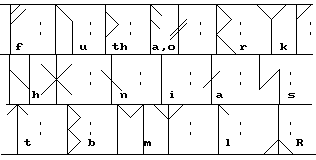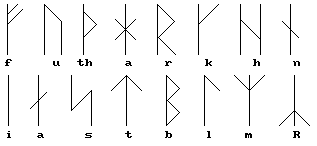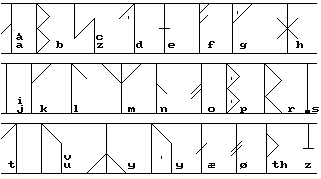| *fehu | *uruR | *þurisaR | *ansuR | *raidu | *kauna | *gebu | *wunju |
| *hagalaR | *naudiR | *isaR | *jara | *perþu | *iwaR | *algiR | *sowilu |
| *tiwaR | *berkana | *ehwaR | *mannaR | *laguR | *ingwaR | *dagaR | *oþila |









"Training sticks" have been found which were used to learn runes, showing that more people could write and read than one had previously believed. It is interesting that knowledge of runes was not taught in the schools of the time which were run by the Christian church and clergy. Church and clergy schools were limited to those who could raise money for the fees. Therefore it appears that common man's knowledge of reading and writing runes was passed down from person to person.
Numerous runic inscriptions from the later years found in archeological diggings in towns, for example Bryggen in Bergen, not only open a new world of thought and ideas, but have brought us in contact with the small merchants and small scale occupations or trades.
Runic inscriptions enter into a regular part of trades and made contributions both in efficiency and specialization. The old brands or trademarks (made of runes) could replace writing out a whole name. Third parties could effectively be brought into trading transactions, debts recorded, or to deputize another to do business for one.
Short inscriptions were used daily about grain, fish, cod, salt, beer, mead, yarn, homespun, cloth, weapons etc. For example:
"Ragnar owns this fishnet."
"Torkjell Coinmaker sends you pepper."
"Bård has paid one and a half øre*, but with scanty weight."
"Henrik has paid two ertog*, but probably with bad silver."
"Ingemund Sheep has paid two and a half ertog*" etc.
The runic trading inscriptions show that this was hardly daily shopping as we know it, because the consignment and the accounts point to much larger purchases of butter, milk, fish, grain, cod, salt, beer etc. But this is an old and well known fact of life of the Norwegian agricultural population.
A "félag", a partnership or company, is what we encounter in a letter written with runes from Tore Fager to Havgrim around 1300. Tore had been on a trading consignment in which he had bad luck. He wrote to Havgrim of the company:
"Tore Fager sends God's and his own greetings, in fellowship and friendship. I lost some of the goods for the company in the trading. I have not gotten the beer or the fish. I want you to know this so that you do not call me to account for this. Ask the farmer to come south and visit us and see how it is. Urge him to it, and do not call me to account for anything; and do not tell Torstein Lang anything. Send me some gloves. If Sigrid needs anything, ask her to come to you. Promise me that I will not get any difficulties because of this lack."
The runic inscriptions lead us into a milieu in which both men and women took an active part in trade. There is mention of Lucia Grimsdatter, Vemund, Eirik, and other common Norwegian names. These people were an important group of traders in the cities. Later the German traders gained the right to also conduct small scale trading, which became a big problem for the local traders.
There is never found any runic inscription with numbers, the accounts is all ways spelled with runes.
RUNIC INSCRIPTIONS TELL US ABOUT THE STREET LIFE
Runic inscriptions from the 12 -1300's have brought us closer to the life in the cities. Most written sources are about important people and happenings, but these runic inscriptions were written by and about people in the street and their ordinary lives.
Small traders and handworkers didn't only write their trademarks on boxes of pepper or yarn or butter. Through the rune scripts we also see their deepest feelings, yearnings and fears. The runic inscriptions also show us the full spectrum of the thoughts of the people of the Middle Ages on everything from traditional paganism and magic (galdr) to Christian piety.
The street inscriptions emphasize the affairs between men and women, again and again:
"Love you me. I love you."
"My dearest, kiss me."
"Kiss me."
"The 'fanabelt' (a folklore belt) increased your beauty."
"Ingebjørg loved me when I was in Stavanger." etc.
Sometimes the popular element showed itself in a fresh way, in smutty inscriptions, such as "Bad is one who brings drinks to the 'fua'." In slang, 'fua' has a double meaning, as vagina or anus, and could refer to homosexuality.
('Fua' in normal language is a 'female fox' or 'fox shit'.). Another inscription has noted that the "Smith has laid with Vigdis of Sneldebeinene."A bone of a cow bearing runic inscriptions was found in Oslo, dating from the late 1100's or early 1200's. According to runologist James Knirk more than one person wrote on this bone, which may have been used as a letter or message. Knirk says one hand wrote the first and forth lines, and possibly the second, but the third line was written by another:
1) hversu fór mál þat er þú reist i krosskirkju
*(The 'Korskirke' was a church in the old Oslo. It's not presaved.)
The runic inscriptions as "Gyda says you should go home" and "Now there is a big noise and a hubub" shows us probably something about the life in public-houses, confirming stories about the lack of sobriety in the towns, and that much drinking and drunkenness was common when people came together. One runic inscription was found in Bergen advertising a public house run by a woman.
RUNIC INSCRIPTION IN STAVE CHURCHES
For some decades, half of the runic inscriptions in Norway were found in churches. But since the archeological diggings in towns, for ex. in Bergen, hundreds of other inscriptions have been found. None of the below mentioned Stave churches are built before 1150.
Borgrund Stave Church
On the walls of the church are several runic inscriptions. Two of these inscriptions are dated to the middle of the 1100's. The first says "Tor wrote these runes in the evening at the St. Olavís Mass". The other inscription says "Ave Maria".
Hegge Stave Church
One runic inscription was found during reconstruction of the church in 1923. "Erling Arnson wrote these runes."
Høre Stave Church
This runic inscription is written on the stave holding the pulpit.
![]()
þa um þat su(mar) ??? þæir brøþr ællingr (o)k auþun
hokoa til kirkiu er ærlinkr i(a/æ).....(l) i niþar ose
"That summer when the brothers Erling and Audun cut
Høyjord Stave Church
A runestave bearing rune script (used like a rosary) has been preserved.
Lom Stave Church
Several runic inscriptions have been found in Lom church. Among others, one says "I have been here together with two other men".
Another was found in 1973 which says "Hovard sends Gudny God's greetings and his own friendship. Now it is my full wish to ask for your hand. If you don't want to be together with Kolbein, think over your marriage plans and let me know your wish."
Torpo Stave Church
One runic inscription in this church says "Toralf made this church."
Urnes Stave Church
Underneath the church a piece of wood was found inscribed with runes that said "Arne priest wants Inga".
Uvdal Stave Church
Two pieces of wood with runes were found under the church floor in 1978. On the first is written:
![]() æirikar rit mer:runar
æirikar rit mer:runar
The text in Norse is "Eiríkr, rít mér rúnar" which means "Eirik, write runes for me." The second inscription is incomprehensible.
Ål Stave Church
One runic inscription in this church says "Toralf made this church", just as in the Torpo Stavekirke.
Other churches I know there are runic inscriptions is the church in Hesby and Talgje.
The Nidaros cathedral in Tronheim also have runic inscriptions. (These are not Stave Churches.)
Pictures Of Norwegian Runic Stones